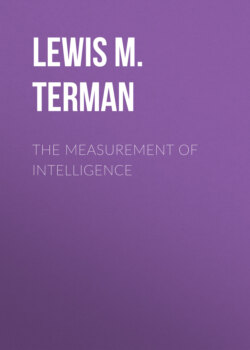Читать книгу The Measurement of Intelligence - Lewis M. Terman - Страница 30
На сайте Литреса книга снята с продажи.
1. The use of age standards.
ОглавлениеBinet was the first to utilize the idea of age standards, or norms, in the measurement of intelligence. It will be understood, of course, that Binet did not set out to invent tests of 10-year intelligence, 6-year intelligence, etc. Instead, as already explained, he began with a series of tests ranging from very easy to very difficult, and by trying these tests on children of different ages and noting the percentages of successes in the various years, he was able to locate them (approximately) in the years where they belonged.
This plan has the great advantage of giving us standards which are easily grasped. To say, for illustration, that a given subject has a grade of intelligence equal to that of the average child of 8 years is a statement whose general import does not need to be explained. Previous investigators had worked with subjects the degree of whose intelligence was unknown, and with tests the difficulty of which was equally unknown. An immense amount of ingenuity was spent in devising tests which were used in such a way as to preclude any very meaningful interpretation of the responses.
The Binet method enables us to characterize the intelligence of a child in a far more definite way than had hitherto been possible. Current descriptive terms like “bright,” “moderately bright,” “dull,” “very dull,” “feeble-minded,” etc., have had no universally accepted meaning. A child who is designated by one person as “moderately bright” may be called “very bright” by another person. The degree of intelligence which one calls “moderate dullness,” another may call “extreme dullness,” etc. But every one knows what is meant by the term 8-year mentality, 4-year mentality, etc., even if he is not able to define these grades of intelligence in psychological terms; and by ascertaining experimentally what intellectual tasks children of different ages can perform, we are, of course, able to make our age standards as definite as we please.
Why should a device so simple have waited so long for a discoverer? We do not know. It is of a class with many other unaccountable mysteries in the development of scientific method. Apparently the idea of an age-grade method, as this is called, did not come to Binet himself until he had experimented with intelligence tests for some fifteen years. At least his first provisional scale, published in 1905, was not made up according to the age-grade plan. It consisted merely of 30 tests, arranged roughly in order of difficulty. Although Binet nowhere gives any account of the steps by which this crude and ungraded scale was transformed into the relatively complete age-grade scale of 1908, we can infer that the original and ingenious idea of utilizing age norms was suggested by the data collected with the 1905 scale. However the discovery was made, it ranks, perhaps, from the practical point of view, as the most important in all the history of psychology.
